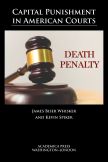Capital Punishment in American Courts
 In the 400 years since the first known execution was carried out for treason in Virginia, American jurisdictions have debated both the appropriateness and methods of capital punishment. Over that time, courts have placed varying restrictions on its application, excluding categories of citizens (for example the insane or the underaged) and evaluating and excluding methods of execution by the U.S. Constitution’s prohibition on “cruel and unusual punishment.” Critics have highlighted controversial issues, including race and class, to argue against capital punishment’s perceived uneven application. Others have argued that capital punishment is “cruel and unusual” in any form and should be outlawed altogether.
In the 400 years since the first known execution was carried out for treason in Virginia, American jurisdictions have debated both the appropriateness and methods of capital punishment. Over that time, courts have placed varying restrictions on its application, excluding categories of citizens (for example the insane or the underaged) and evaluating and excluding methods of execution by the U.S. Constitution’s prohibition on “cruel and unusual punishment.” Critics have highlighted controversial issues, including race and class, to argue against capital punishment’s perceived uneven application. Others have argued that capital punishment is “cruel and unusual” in any form and should be outlawed altogether.
Most recently, the U.S. Supreme Court has ruled, in a 5-4 bare majority, that capital punishment is not cruel and unusual for the crime of murder, provided certain factors are also present. In the same decision it held that infliction of pain of during an execution did not bar its application. States remain free to employ the death penalty or not, and if so, choose freely the method each state deems most appropriate.
In Capital Punishment in American Courts, distinguished political scientists James B. Whisker and Kevin R. Spiker survey this history from a penetrating new perspective.
ACADEMICA PRESS
1727 Massachusetts Avenue, NW, Suite 507
Washington, DC 20036
academicapress.editorial@gmail.com
